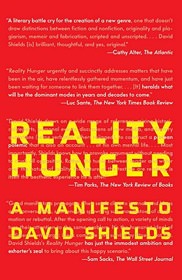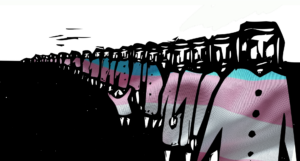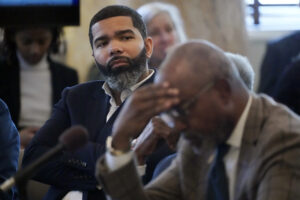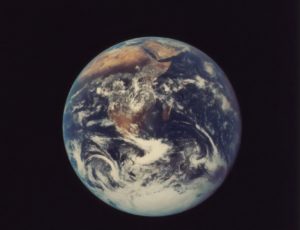‘Reality’ Revisited
Because society has moved into new realms of storytelling, traditional conventions, especially the standard, Victorian formula of the novel, are passé, David Shields argues in "Reality Hunger." The contours of fact and fiction are now blurred, so why can't the novel—or the biography, for that matter—be just as mixed up and piecemeal?The head-spinning feeling of vertigo that comes with being unsure of what is real and what is not is the essence of David Shields' "Reality Hunger: A Manifesto."
Many years ago, when I first encountered Garrison Keillor and his droll tales of the good people of the sad town of Lake Wobegon, I took the stories to be true. Young and unaware of National Public Radio, I was unfamiliar with the author and the weekly radio program on which Keillor weaves amusing and sweet tales of the fictional Minnesota town. When I finally discovered my folly I felt only a tinge of embarrassment at having been swindled. Mostly I was thrilled because what I had taken to be real was revealed to be imaginative. The rug of perception had been yanked out from under me; my mind and emotions had been taken for a ride, and I loved the feeling.
It sounds a little silly. Yes, Garrison Keillor duped me. But who hasn’t been hoodwinked in similar fashion? Millions of innocent foils were taken by James Frey’s “A Million Little Pieces” (Random House, 2003) and the shaky-camera breakthrough mockumentary “The Blair Witch Project” (1999). Even the venerable New York Times was sold a bill of goods by the plagiaristic reporting of Jayson Blair. It does not matter by whom or what we have been taken for a ride—what matters is that, at one time or another, we all have put our weight onto something we believed to be real, only to fall flat once the foundation of “truth” was removed. And that’s exciting.
The head-spinning feeling of vertigo that comes with being unsure of what is real and what is not is the essence of David Shields’ “Reality Hunger: A Manifesto.” In a culture driven (and riveted) by pseudo-reality, infotainment and superficial forms of distraction (think: “reality” television, Auto-Tune, Glenn Beck), Shields is bored with traditional forms of narrative in novels. Because society as a whole has moved into new realms of storytelling, traditional conventions, especially the standard, Victorian formula of the novel, are passé. The black-and-white contours of what constitutes fact (Wikipedia) and fiction (“Curb Your Enthusiasm”) are blurred, so why can’t the novel—or the biography, for that matter—be just as gray?
In other words, Shields demands that the novel (and some forms of nonfiction) be reinvented to match the frenetic, mixed-up, piecemeal 21st century world we live in. Anything short of this reinvention renders the novel—as we know it—a nostalgic art form.
To drive the point home, “Reality Hunger” is itself a meta-critical work of art (I use the term art hesitantly, but purposefully). The book is a collage; most of the numbered 617 vignettes and aphorisms that constitute the manifesto are the words of others (Matisse, Bellow, Mailer, you name it), though rarely are the idea originators cited. To wit, item 174: “The genius of memory is that it is choosy, chancy, and temperamental.” Who said that? Shields? Horace? Who knows? Who cares?! Shields borrows from others with abandon and without citation to put the reader at unease—to force the audience into a situation where up is difficult to discern from down, where fact cannot be distinguished from fiction, where Shields cannot be separated from Chekhov. Indeed, the fact that most of the book is borrowed material is not even revealed until halfway through, at which point—though I was sitting still—I experienced vertigo. What or who had I been reading up until that point? The rest of the book, then, while already captivating, became a thrill to read.
The life of the average American is a continuous, rapid-fire onslaught of information, disinformation and infotainment, in which fact cannot be easily distinguished from fiction. The 21st century novel should reflect this, Shields contends. He calls for genre-exploding material that extends beyond the realm of biography and literature. Writers must catch up to other forms of art (like mixed-media art or hip-hop music). And if they can’t, then the novel as we know it is dead. “Although great novels—novelly novels—are still being written, a lot of the most interesting things are happening on the fringes of several forms” Shields, or someone, says.
|
To see long excerpts from “Reality Hunger” at Google Books, click here. |
While publisher Knopf’s lawyers demanded that citations be put into the book somehow, some way, Shields pleads for readers to not only ignore the references in the back, but to take a knife to them and remove them completely. Respecting his wishes, but leery of ripping pages out of a book, I honored his request: “Stop; don’t read any farther,” he pleads, and I obliged. Thus, in this essay, unless the quote comes from chapter “t,” initialed “ds,” I cannot tell the reader if it is Shields or another whom I am quoting. Well, except for one: “When we are not sure, we are alive,” says one epigraph (Graham Greene). “Reality Hunger” is more than a manifesto—it’s an experience.
Laying a Foundation
Some critics have erroneously accused Shields of being anti-fiction. Nothing could be further from the truth. “Reality Hunger” is peppered with authors and novels that excite him deeply, from the well known to the obscure: E.M. Forster, F. Scott Fitzgerald’s “The Crack-Up,” Renata Adler’s “Speedboat,” Michael Lesy’s “Wisconsin Death Trip,” David Foster Wallace, to name merely a few.
What Shields laments is not the story, but the story as it is popularly told and accepted, an antiquated form that has changed little since novels emerged in Victorian times as entertainment for homebound, upper-society women. The world of the 21st century is one of rapidity and technological change that is remarkably distinct from 19th century living. Why is it, then, that literature has not evolved as well? While many art forms have gone through tumultuous change, experimenting with many frameworks and methods, the novel as a form remains predictable. “The kinds of novels I like are ones which bear no trace of being novels,” Shields declares.
These are trying times for the would-be novelist. Just think of all the competition inside and outside traditional forms of media: blockbuster films, the Internet, smart phones, 24-hour news, “American Idol,” tea party gatherings, Sarah Palin, Balloon Boy, celebrity gossip and mishaps, more and more “reality” television, the iPad, Facebook, Twitter, Tumblr, and on and on.
The American writer has his hands full, trying to understand and then describe and then make credible much of American reality. It stupefies, it sickens, it infuriates, and finally it is even a kind of embarrassment to one’s own meager imagination. The actuality is continually outdoing our talents, and the culture tosses up figures almost daily that are the envy of any novelist.
Not only are the distractions from the printed novel profligate, they are increasingly fascinating. People are fictionalizing segments of their “reality” in order to gain fame (Balloon Boy), fortune (Bernie Madoff) or followers (Sarah Palin). Conversely, fictional or “unreal” elements of life are being molded and shaped into increasingly “real” existences (e.g., the massively popular online video game, Second Life). Fiction, it is declared, has “never seemed less central to the culture’s sense of itself.” And bitingly, “Is it possible that contemporary literary prizes are a bit like the federal bailout package, subsidizing work that is no longer remotely describing reality?”
As I see it, three foundational elements shape Shields’ call to arms, of which the first two are closely related: genre breaking, unsurety, and “in-scaping.” Combined, these elements better capture our collective societal experience, and create excitement for both the originator and the audience. Breaking Through
A quote from Walter Benjamin sets the first foundation: “All great works of literature either dissolve a genre or invent one. Let Us All Now Praise Famous Men. Nadja. Cane. Oh, What a Blow That Phantom Gave Me! ‘The Moon in Its Flight.’ Wisconsin Death Trip. Letters to Wendy’s.”
Examples of other genre inventions include Beethoven’s “Eroica,” or more contemporarily, the advent of hip-hop, MTV’s “The Real World,” the urban art of Shepard Fairey and Banksy, and the abstraction of Kandinsky. These contributions to entertainment are unique and elemental because they not only turned convention on its head, but have also become mainstays in cultures worldwide. They represent genres now unto themselves (and, so, must also be exploded if we are to move beyond them).
Genre fiction, writes Shields, is “novels based on novels based on novels, in which every convention of character and plot has been trotted out a thousand times before.” And so we also need not only inventors, but also genre dissolvers like Roberto Bolaño, whose writing attempts to unchain Latin American writers from the boundaries of magical realism, or David Foster Wallace, whose fiction pleads for the sustained navel-gazing monologue to break the bland forms of postmodern character development, or lack thereof.
As far as literature is concerned, the realization of Shields’ call for genre-breakers and -dissolvers can be achieved in two ways: through collage, and by careful, meticulous, purposeful construction of a false narrative passed off as truth, or the opposite—an actuality so absurd it can only be deemed a work of fiction (the manifestation of “truth is stranger than fiction”). This latter method comes about through the successful translation of the often-disturbing honesty that lies at the core of each and every one of us, the private mind that is inwardly consulted minute after minute (the 99 percent of our mindful existence), but very rarely shared. See David Foster Wallace as a guide for this path.
The successful combination of these two “breaking through” methods—collage and false narrative—may prove to be as seminal as “The Iliad” was to Western literature, as abstraction was to modern art, as the electric guitar was to music.
In-scape Artists
The second foundational element of Shields’ manifesto is a sentiment summed up in Franz Kafka’s famous dictum, “a book must be the ax for the frozen sea inside us.” Great writing (and great art, for that matter) reveals a kernel of insight as to how the creator handles being. Ultimately, we are all alone, living within our own minds and doing our very best to cope with the material conditions that surround us and constitute this thing called “life.” Any medium, therefore, that helps traverse the abyss of alone-ness (loneliness?) between individuals is a work worth pursuing and engaging. Shields cites Amy Fusselman’s “The Pharmacist’s Mate,” a story that puts the struggle of the self at the center of the novel, as an achievement in this category, one that accomplishes this high level of “in-scaping”—that is, an escape into the deep hollows of the inner self and the successful translation and connection of the inner self to others outside that mind. “So: no more masters, no more masterpieces. What I want (instead of God the novelist) is self-portrait in a convex mirror.”
Candor is key—being willing to say what no one else is willing to say. The act of writing is inevitably viewed as an act of courage (brave is all over the place). Life’s difficult, maybe even a drag; language is (slim) solace. No one else gets what you’re doing; I alone get it. You and me, babe. Intimacy. Urgency. We alone get life. Let me explain your book—the text—to yourself. Let me tell you what your book is about. Life is shit. We are shit. This, alone, will save us—this communication.
What in-scaping demands, if it is to span an emotional or existential crevasse in order to link to separate souls and minds, is naked honesty.
Vertigo
The third and most essential foundational element for Shields’ manifesto comes from Graham Greene, as previously noted: “When we are not sure, we are alive.” In other words, to be lulled into a complacent, predictable, unexciting existence is to be numb. You might as well be dead. To experience vertiginous doubt, where the dream world is mixed with the real world, where fact and fiction are as gray as London skies, where genres are melted and remolded into new entities, is to truly be alive. When your head spins and your heart skips beats and your stomach drops, you can feel it. You are alive.
Is it possible to foster and sustain this unsurety in literature? “Early novelists felt the need to foreground their work with a false realistic front,” Shields recalls. “Defoe tried to pass off Journal of a Plague Year as an actual journal. Fielding presented Jonathan Wild as a ‘real’ account. As the novel evolved, it left these techniques behind.” And it worked. The audience was often duped. Even outlandish fantasies like Jonathan Swift’s “Gulliver’s Travels” with miniature people and giants pulled the same trick. It may not be a widespread conceit these days, but despite Shields’ contention otherwise the concept has not been entirely left behind. The intentional perpetration of fraud has recently been revived by, yes, Dan Brown. The opening page of “The Da Vinci Code,” a global phenomenon and controversial blockbuster, boldly states, “FACT” before claiming that the organization at the crux of the thriller—the Priory of Sion—is a real organization founded in 1099. Never mind that the group is an amalgam of the real and imagined and was created in 1956. Millions of readers around the world fell for it. “The Da Vinci Code” may not be high art, but it certainly spun some heads.
Provocatively, Shields’ call to blur the lines between what is real and what is not extends into autobiography as well, for “the line between fact and fiction is fuzzier than most people find it convenient to admit.” Everyone fudges memories, whether purposefully or not. Hillary Clinton did land in Bosnia, but not under a rain of gunfire, as she casually admitted. Relationships end, but easier than admitting fault is convincing ourselves that something else was the cause of the rupture.
And so, in the autobiographical realm, Shields says:
There are two unmistakable and distinctly positive effects of novels-as-autobiography like Frank Conroy’s Stop-Time and Frederick Exley’s A Fan’s Notes: first, they deliberately undermine the traditional and largely spurious authority of the novelist by depriving him of his privileged position above and beyond the world; and second, they narrow the gap that exists between fiction and autobiography, a gap that is artificial to begin with.
Let us not limit the blurry experience to autobiography, however. Charlie Kaufman’s film “Adaptation” presents an excellent meld of fantasy and personal history. So are rapper Eminem’s albums “Slim Shady” and “Marshall Mathers.”
Here is where Shields and I disagree. The stakes are high. If we accept that biographers and autobiographers are allowed to purposefully fictionalize historical engagements, how are we—as a global civilization—to accurately record, and thus learn from and improve upon, our human experiences? Historical misinformation deliberately delivered for the sake of polishing one’s image or just for the heck of it disservices future generations that seek to continue the progress of humanity. If they cannot trust supposedly historical accounts, how can they build on the foundation thousands of generations before them have lain? Exploding fictional genres is one thing; blurring the “non/fiction” lines of biography and autobiography sets a disturbing precedent. On a lighter but equally thoughtful note, in trying to untangle what is real and what is not in autobiography, we come across this provocative gem in “Reality Hunger”:
The ideal of unmediated reporting is regularly achieved only in fiction, where the writer faithfully reports on what’s going on in his imagination. … We must always take the novelist’s and the playwright’s and the poet’s word, just as we’re almost always free to doubt the biographer’s or the historian’s or the journalist’s. In imaginative literature we’re always constrained from considering alternative scenarios; there are none. This is the way it is. Only in nonfiction does the question of what happened and how people thought and felt remain open.
This point makes a lasting impression. When an author of, say, a war story describes an act of cowardice, we accept it. The soldier was a coward. He failed to act not because he was held back or was incapacitated, but because he was simply afraid. The author says so, we accept. Done.
If, however, the story is an autobiographical record of wartime exploits, and the writer says he had to stay hidden in the trench rather than attempt a rescue because he, say, thought his friend had already perished. Well … did he really think that? Or is he just saying so to make himself look better for posterity? Did he actually chicken out and is too embarrassed to say so? In other words, we are skeptical of the account. The author might have actually thought his friend was dead, but he also might have been a coward. We are free to question this material. With the novel, this interrogation is not an option. And so, novels can be seen to be more truthful and honest than an autobiographical account ever could.
We act astonished, even dismayed, when we find out that the memoiristic voice is doing something other than putting down facts. We know that’s not the case, but we’re constantly struggling with this inevitability as if with the transgressions of a recidivist pedophile. We need to see the genre in poetic terms.
Shields knows memoirs are fictions, because how we see ourselves is either an approximation or an idealization of the truth. Our own autobiographical reflections, no matter how hard we try to temper the act, are truly fictions. Shields knows this; he just wishes the rest of us would accept it and move on so that truly great works can be created … or fabricated. For Shields, nothing could be truer than fiction, and nothing is more questionable than autobiography. I find myself to be extremely drawn to this argument.
Talk about vertigo. …
Finding Meaning
Books (and other art forms) that combine the three foundational elements just discussed are nothing short of exciting and invigorating, both for the creator and for the reader (or listener, viewer). Lines between fact and fiction, reality and unreality, must be blurred, because our lives are amalgams of truths and lies. Nonfiction is an art, and therefore it must cease to be held to the same standards of proof and verification of journalism. Thucydides’ “The History of the Peloponnesian War,” a founding document of Western civilization, is chock-full of quotes of generals the author entirely invented.
Inasmuch, fiction can speak truth, a concept with which many readers are already intimate. The novel “The Dharma Bums” by Jack Kerouac is a truer account of a young man trying to find himself than many memoirs will ever be. Fiction and nonfiction—need we even have the genres distinguished anymore? Shields would eliminate the labels in a heartbeat.
“Reality Hunger” is not a cataclysmic piece (or collection) of writing. Yes, it bends genre and bucks tradition (who is speaking? Shields? Beckett?). Rather, much like plastique in explosives or the powder in a keg, it is an enabling agent. Or, to use a more contemporary likening, “Reality Hunger” is an improvised explosive device (IED): It is improvised with its collage-like construction. It is explosive in its call to arms for the subversion and re-creation of artistic norms. And in bound pages or electronic form, the book is a device that delivers an explosive, potentially damaging message.
Perhaps, though, Shields should have titled his manifesto “Honesty Hunger,” as it seems his book is not so much a paean for reality, though it is, but a call for and an acceptance of Truth. And if that cannot be had, then the acknowledgment of such, and the acceptance of the second-best form of existence: reality.
I am captivated by “Reality Hunger” because I cannot form a definite opinion on Shields’ work. The problem for me does not lie in praising and expounding collage or sampling as mediums (though I am a fan of hip-hop), nor does it come in the call to blur the lines between reality and unreality (Larry David is a genius in such mixology). It’s the call to arms to constantly reinvent (or demolish entirely) the novel as a form of storytelling that draws me.
Nevertheless, I am consistently captivated by what Shields determines to be long, protracted, contrived novelistic forms. “There’s inevitably something terribly contrived about the standard novel,” he says, “you can always feel the wheels grinding and going on.” But why is that necessarily problematic? I may have been taken by Garrison Keillor, but before I realized it was untrue I enjoyed “Lake Wobegon Days,” despite its traditional construction and unsurprising format. I like “The Grapes of Wrath” and “Moby Dick” and “Things Fall Apart”—novels that are explosive because of their lyricism, not because they are genre dissolvers.
If every book destroyed a genre, reading might cease to be a pleasure, and instead become a chore for the mind. Predictability of formula can be satisfying—it is why we watch Disney films and “Law & Order.” We know and like the arc of their dramas. Save the laurels for those that do defy expectations, just don’t demand that the reader make equally heroic efforts every time a page is turned. To do otherwise may prove exhausting.
Asked by radio talk show host Leonard Lopate about what books we would be reading in a hundred years, Shields hadn’t the faintest clue, other than to note that we would not be reading the novels we are reading today. His words will be prophetic only if the literary world takes to heart his manifesto. For according to Shields, if we are to be reading anything remotely different in 100 years, our literary canon must be obliterated and created anew. One wonders if “Reality Hunger” will be the spark for this explosive demolition.
Shaun Randol is the founder and editor-in-chief of The Mantle (www.mantlethought.org). He is also an associate fellow at the World Policy Institute in New York City (www.worldpolicy.org) and a member of the National Book Critics Circle.
Your support matters…Independent journalism is under threat and overshadowed by heavily funded mainstream media.
You can help level the playing field. Become a member.
Your tax-deductible contribution keeps us digging beneath the headlines to give you thought-provoking, investigative reporting and analysis that unearths what's really happening- without compromise.
Give today to support our courageous, independent journalists.







You need to be a supporter to comment.
There are currently no responses to this article.
Be the first to respond.